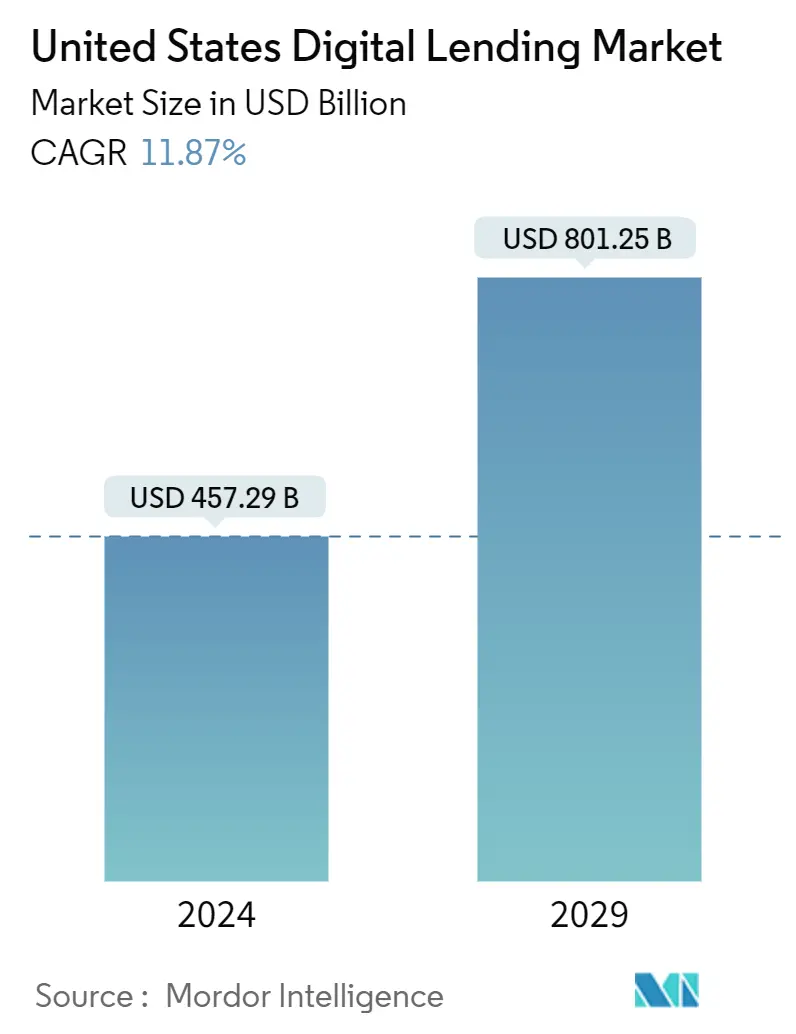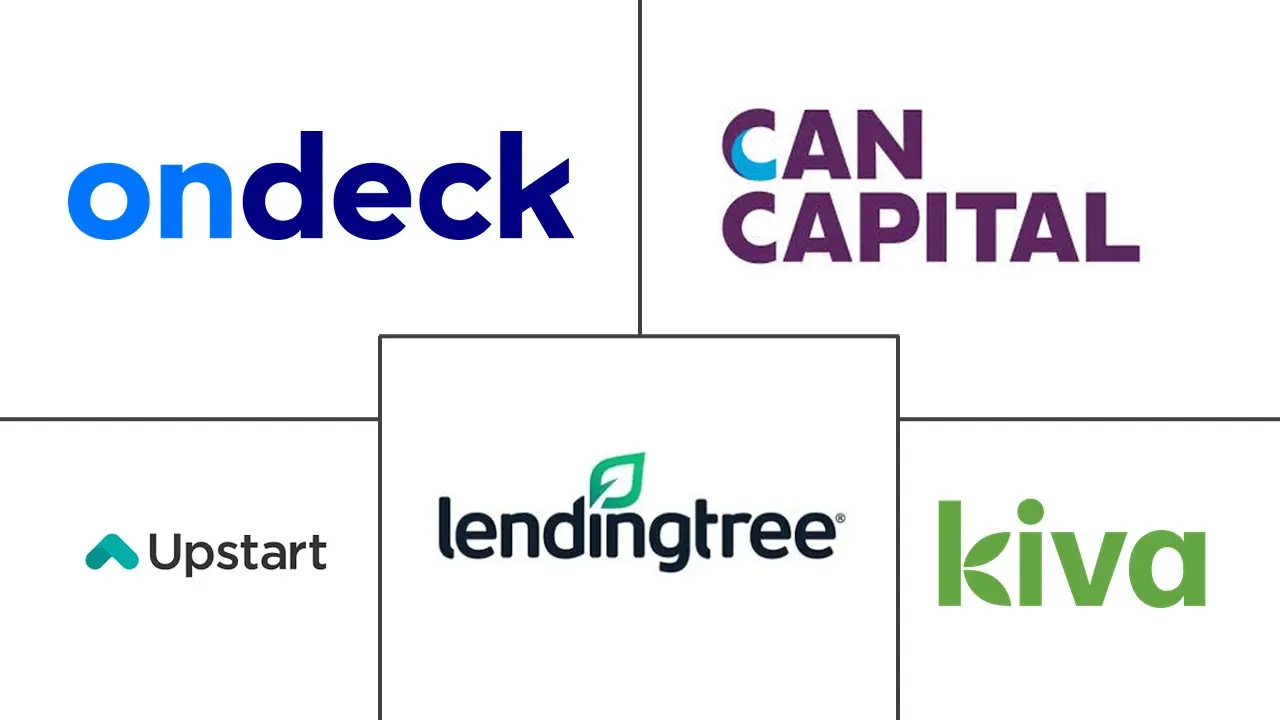Market Size of United States Digital Lending Industry

| Study Period | 2019 - 2029 |
| Base Year For Estimation | 2023 |
| Market Size (2024) | USD 457.29 Billion |
| Market Size (2029) | USD 801.25 Billion |
| CAGR (2024 - 2029) | 11.87 % |
| Market Concentration | Medium |
Major Players
*Disclaimer: Major Players sorted in no particular order |
United States Digital Lending Market Analysis
The United States Digital Lending Market size is estimated at USD 457.29 billion in 2024, and is expected to reach USD 801.25 billion by 2029, growing at a CAGR of 11.87% during the forecast period (2024-2029).
Market expansion is anticipated to be fueled by the advantages provided by digital lending platforms, such as improved loan optimization loan process, quicker decision-making, compliance with regulations and norms, and improved corporate efficiency. Traditional lending platforms required physical contact and human engagement at every stage, which prolonged processing times and raised the possibility of human error. However, digital lending platforms allow banks to automate the loan process, improving consumer satisfaction.
- The United States is one of the largest and most advanced markets for digital lending globally due to its early adoption of digitization in various sectors. Also, factors such as the strong economy and robust presence of prominent solution providers, coupled with strong investment by government and private organizations for the development and growth of research & development activities, are poised to drive the demand for digital lending in the region.
- Funding is a crucial element of the digital lending business model. There are three major funding models used by digital lenders: Marketplace lenders, Balance sheet lenders, and bank channel lenders. Several digital lenders have been tapping multiple funding models as they grow.
- Further, banking institutions retain certain fundamental competitive advantages. Arguably the most important is their access to insured deposits, which affords them low-cost capital. Regulatory concerns have likely caused banks to hesitate when adopting new technologies, but banks are increasingly looking for points of entry to the fintech space. It is expected that many banks will partner with existing fintech companies to have their cost advantages with the fintech's technological capabilities.
- By combining their technological expertise with banks' lower cost of capital, these partnerships could enable banks to provide more efficient customer experiences at lower rates and open them up to previously untapped customer segments. Also, in the United States, platforms engaging in credit origination can be subjected to licensing requirements in each state. For this reason, many platforms partner with the banks to originate loans agreed online.
- Owing to the COVID-19 pandemic, SMEs in the region faced challenges in raising funds during the crisis to keep their businesses operating. Digital Lending is expected to find several opportunities, especially among SMEs, for growth and adoption. Further, during the COVID-19 pandemic, the government aimed to support the people. Moreover, given widespread job losses, wage reductions, and a severe liquidity shortage, banks and financial institutions (FIs) anticipates to experience an increase in credit costs and non-performing assets ratio as the effects of COVID-19 on the lending industry develop. Lenders can benefit significantly from the use of technology to assist them in adjusting to the new normal.
United States Digital Lending Industry Segmentation
Digital lending is the process of disbursing and collecting loans via websites or mobile apps. It enables prompt disbursal and aids in cost reduction. Non-Banking Financial Companies (NBFCs) and Lending Service Providers (LSPs) work together to provide credit to clients using the latter's platform.
The United States digital lending market is segmented by type (business digital lending, consumer digital lending).
The market sizes and forecasts are provided in terms of value (USD) for all the above segments.
| By Type | ||||||
| ||||||
|
United States Digital Lending Market Size Summary
The United States digital lending market is poised for significant growth, driven by the advantages of digital platforms over traditional lending methods. These platforms enhance loan optimization, expedite decision-making, and ensure compliance with regulations, all while improving corporate efficiency. The shift from physical interactions to automated processes has reduced processing times and minimized human errors, leading to increased consumer satisfaction. The U.S. stands as a leader in the global digital lending landscape, bolstered by its early adoption of digitization, a strong economy, and the presence of major solution providers. Government and private sector investments in research and development further support the market's expansion.
Digital lending in the U.S. is characterized by diverse funding models, including marketplace, balance sheet, and bank channel lenders, with many companies leveraging multiple models to scale their operations. Partnerships between banks and fintech companies are becoming more common, allowing banks to combine their cost advantages with fintech's technological prowess, thereby enhancing customer experiences and reaching new market segments. The COVID-19 pandemic highlighted the potential of digital lending, particularly for SMEs facing funding challenges. As traditional banks hesitated to extend small-dollar loans, technology-driven lenders filled the gap, attracting attention for their ability to collaborate with banks and address unmet credit demand. The market is semi-consolidated, with increasing investments and mergers and acquisitions, as established tech giants leverage their distribution channels and business relationships to gain a competitive edge.
United States Digital Lending Market Size - Table of Contents
-
1. MARKET INSIGHTS
-
1.1 Market Overview
-
1.2 Regulatory Landscape
-
1.3 Key Indicators for Personal Loan Borrowers in the United States
-
1.3.1 Percentage of Loan Debt in United States Held By Borrowers
-
1.3.1.1 Super Prime
-
1.3.1.2 Prime Plus
-
1.3.1.3 Prime
-
1.3.1.4 Near Prime
-
1.3.1.5 Sub Prime
-
-
1.3.2 Average Outstanding Balances in United States Held By Borrowers
-
1.3.2.1 Super Prime
-
1.3.2.2 Prime Plus
-
1.3.2.3 Prime
-
1.3.2.4 Near Prime
-
1.3.2.5 Sub Prime
-
-
1.3.3 Delinquency Rates of Borrowers in United States
-
1.3.3.1 Super Prime
-
1.3.3.2 Prime Plus
-
1.3.3.3 Prime
-
1.3.3.4 Near Prime
-
1.3.3.5 Sub Prime
-
-
-
1.4 Analysis of Origination Volumes of Digital Lenders
-
1.4.1 Personal Loans
-
1.4.2 SME Loans
-
-
1.5 Analysis of Subprime Borrowers in the United States
-
1.5.1 Distribution by States
-
1.5.2 Demographic Breakdown by Age
-
1.5.3 Overall Shrinking of Subprime Population in the Country
-
-
-
2. MARKET SEGMENTATION
-
2.1 By Type
-
2.1.1 Business
-
2.1.1.1 Business Digital Lending Market Dynamics
-
2.1.1.2 Business Digital Lending Ecosystem (including both Startups and Incumbents)
-
2.1.1.3 Market Size Estimates and Forecasts
-
-
2.1.2 Consumer
-
2.1.2.1 Consumer Digital Lending Market Dynamics
-
2.1.2.2 Consumer Digital Lending Models (Payday Lenders, Peer-to-peer Loans, Personal Loans, Auto Loans, and Student Loans)
-
2.1.2.3 Consumer Digital Lending Ecosystem (including both Startups and Incumbents)
-
2.1.2.4 Market Size Estimates and Forecasts
-
-
-
United States Digital Lending Market Size FAQs
How big is the United States Digital Lending Market?
The United States Digital Lending Market size is expected to reach USD 457.29 billion in 2024 and grow at a CAGR of 11.87% to reach USD 801.25 billion by 2029.
What is the current United States Digital Lending Market size?
In 2024, the United States Digital Lending Market size is expected to reach USD 457.29 billion.

